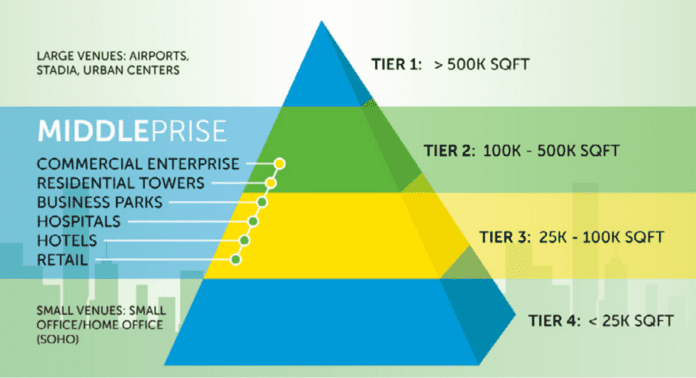Learn how ip.access and Baicells are addressing the need for multi-carrier small cells
Providing ubiquitous cellular coverage and capacity inside buildings is a big challenge the vendor community is working to solve. Big venues–think stadiums, transit hubs and other marquee locations–generally feature multi-carrier, multi-band distributed antenna systems (DAS), which are often funded by a neutral host provider or by mobile carriers. But, big venues aren’t the problem. The problem is buildings less than 500,000-square-feet–hotels, retail spaces, commercial enterprises, residential buildings, hospitals, business campuses and the like. Infrastructure vendor Solid coined the term “middleprise” to describe this hugely underserved market.
DAS is too expensive for these buildings, but the owners can’t not provide in-building cellular because it can dramatically impact tenant leasing rates and retention. Small cells are generally used in facilities where only one or two carriers is present, or where a pinpoint coverage and/or capacity issue is being addressed. But, in a scenario where multiple carriers are present, this would generally require duplicate small cell units, which can be problematic from an installation and aesthetic perspective.
That’s where multi-carrier small cells come in. From his recent report titled “Multi-Carrier Small Cell Solutions for In-Building Wireless,” Wireless 20/20 analysts Randall Schwartz and Berge Ayvazian write, “The critical question is which solutions can provide the multi-carrier capabilities needed for most venues at a cost point which can encourage a faster rate of deployment. While small cells can meet the cost-points required for in-building coverage, they have been challenged to provide coverage for more than one carrier at a time. But new virtualized small cell solutions have become available that can face the challenge of addressing the economic and multi-carrier requirements of the small and medium size venues.”
Ip.access, for example, has brought to market the Viper platform, which includes proprietary SUMO (super multi-operator) technology, which enables shared access small cells. According to ip.access, SUMO allows “each access point broadcasts multiple PLMN codes on the same spectrum and all users see the AP as a cell within their home network. A policy based resource scheduler in the AP allocates capacity and bandwidth according to predefined rules managed via SLAs. The Viper gateway then securely routes all traffic to the appropriate core network for each operator.”
Another player in this space is Baicells, which made a splash at Mobile World Congress this year by touting the “first real” small cell for neutral host or multiple operators. Called NeutralCell, the company says the multi-operator solution delivers “a single small cell that can be used by multiple operators. NeutralCell meets the requirements of communication systems from different operators for the frequency band and transmitted power. Neutral host service providers can deploy NeutralCell at a site and then deliver wireless service at the facility to various operators by renting this station to them. In this way, operators can resolve the difficulty in the arrangement of special sites, save on building and operation costs, and build up their networks quickly.”
Solid, the company that initially labeled the “middleprise,” is working to address this valuable market through an innovative take on DAS, Genesis, which provides a multi-carrier solution, but further shifts ownership to the venue owner and provides a marketplace for carriers to purchase capacity back from the system owner. “It’s a totally new approach to in-building wireless where the building owner outfits their properties with affordable, new generation DAS solution, including the signal source component,” according to the company. Solid Americas President Ken Sandfeld called Genesis a “game-changer.”
It’s a totally new approach to in-building wireless where the Building Owner outfits their properties with affordable, new generation DAS solution, including the signal source component. It’s a 180 degree shift in ownership that enables building owners to enter into agreements with wireless service providers to provide their signal to the building’s DAS. In turn, wireless service providers increase their capacity while reducing their cost, yet they maintain the visibility and control they require. Both players win, and both get better results at far lower cost than ever before.
Schwartz and Ayvazian concluded that cost-effective, multi-operator solutions are required to address the middleprise.

